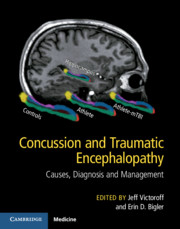Book contents
- Concussion and Traumatic Encephalopathy
- Concussion and Traumatic Encephalopathy
- Copyright page
- Dedication
- Contents
- Guiding Apophthegm
- List of Contributors
- Preface
- Acknowledgments
- Introduction
- Part I What Is a Concussion?
- Part II Outcomes after Concussion
- 7 Why Outcomes Vary
- 8 Emotional Disturbances Following Traumatic Brain Injury
- 9 Concussion and the 21st-Century Renaissance of Neuropsychology
- 10 Persistent Post-Concussive Psychiatric Problems
- 11 Late Effects
- 12 Functional Neuroimaging Markers of Persistent Post-Concussive Brain Change
- 13 Polypathology and Dementia After Brain Trauma: Does Brain Injury Trigger Distinct Neurodegenerative Diseases, or Should They Be Classified Together as Traumatic Encephalopathy?
- 14 Traumatic Encephalopathy: Review and Provisional Research Diagnostic Criteria
- Part III Diagnosis and Management of Concussion
- Index
- References
13 - Polypathology and Dementia After Brain Trauma: Does Brain Injury Trigger Distinct Neurodegenerative Diseases, or Should They Be Classified Together as Traumatic Encephalopathy?
from Part II - Outcomes after Concussion
Published online by Cambridge University Press: 22 February 2019
- Concussion and Traumatic Encephalopathy
- Concussion and Traumatic Encephalopathy
- Copyright page
- Dedication
- Contents
- Guiding Apophthegm
- List of Contributors
- Preface
- Acknowledgments
- Introduction
- Part I What Is a Concussion?
- Part II Outcomes after Concussion
- 7 Why Outcomes Vary
- 8 Emotional Disturbances Following Traumatic Brain Injury
- 9 Concussion and the 21st-Century Renaissance of Neuropsychology
- 10 Persistent Post-Concussive Psychiatric Problems
- 11 Late Effects
- 12 Functional Neuroimaging Markers of Persistent Post-Concussive Brain Change
- 13 Polypathology and Dementia After Brain Trauma: Does Brain Injury Trigger Distinct Neurodegenerative Diseases, or Should They Be Classified Together as Traumatic Encephalopathy?
- 14 Traumatic Encephalopathy: Review and Provisional Research Diagnostic Criteria
- Part III Diagnosis and Management of Concussion
- Index
- References
Summary
- Type
- Chapter
- Information
- Concussion and Traumatic EncephalopathyCauses, Diagnosis and Management, pp. 573 - 581Publisher: Cambridge University PressPrint publication year: 2019

